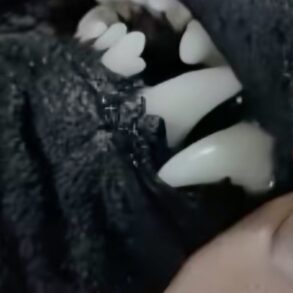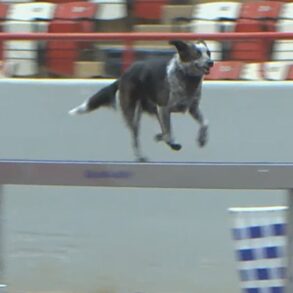It’s a regular occurrence when taking our canine pals for drizzly walks and summer swims. But until recently, the biology behind the water-flinging, human-drenching, muzzle-distorting “wet dog shake” has mystified scientists working to decode the sense of touch.
Last month, researchers in the lab of David Ginty, the Edward R. and Anne G. Lefler Professor of Neurobiology and chair of Harvard Medical School’s Neurobiology Department, reported in work published in the journal Science that they’d used cutting-edge techniques to track sensory signals that underlie wet dog shakes from receptors on the skin to a part of the brain called the parabrachial nucleus.
Using tools — many developed in the Ginty lab — that allow researchers to isolate and trace single neurons and stimulate or block them using light, the researchers determined that the shaking behavior can be evoked by activating a class of sensory neurons called C-LTMRs and, conversely, the number of wet dog shakes evoked by mechanical stimuli decreases when C-LTMRs and the parabrachial nucleus are muted.
The researchers determined that the shaking behavior can be evoked by activating a class of sensory neurons called C-LTMRs.
Though unseen in humans, the motion is universal among fur-bearing mammals, serving as something of an early warning system that insects, dirt, water, and other substances are about to come into contact with the skin. Occurring in everything from grizzly bears to dogs and cats to lab mice, the response is innate, Ginty said, meaning that, though reflexive, it can be controlled by the animal. In humans, Ginty compared it to feeling a bug landing on your arm: You may jerk your arm or flick at it with your other hand with little thought, but it can be controlled if desired. In Ginty’s lab, researchers used droplets of sunflower oil applied to the upper back to trigger the response in mice who’d been genetically engineered so that specific neurons could be stimulated or blocked using light.
“One thing we’ve done over the last 15 to 20 years is generate genetic tools that allow us to study each of the sensory neurons that associate with the skin in isolation and that’s been incredibly powerful,” Ginty said.
The skin has approximately 20 different types of sensory receptors, including those that detect hot, cold, itch, and touch. Twelve or so receptors detect different types of touch, from a quick stab of pain to vibration to steady pressure to a soft caress. The signal triggering the “wet dog shake” starts in C-LTMRs, or C-fiber low threshold mechanoreceptors, which wrap around the base of a hair follicle. The receptor is one of the body’s most sensitive and can pick up the slightest movement of the hair or a depression of the skin around the hair’s base.
From the receptor, the signal travels along nerve cells into the spine, where it joins with the spinal cord. The signals then emerge from the spinal cord and travel to the brain stem and the parabrachial nucleus. Beyond enhancing our understanding of a basic and familiar mammalian behavior, Ginty said that the techniques developed have allowed researchers to overcome a major hurdle — understanding what’s going on inside the spinal cord.
“We understand the logic of organization of the neural circuitry that underlies visual information processing and sound information processing,” said Ginty, whose lab has been focused on unravelling the neurobiology of touch for decades. “For touch — for somatosensory information processing — we’re kind of in a black box trying to understand it because it’s been so challenging to access and record neural activity in the spinal cord.”
Though they’ve tracked the signal to a specific location in the brain, Ginty said many questions remain. An important one is understanding whether the pathway they identified accounts for all the wet dog shake response or, given the limitations of their functional manipulations, if there’s more going on than they were able to see.
“We’re struggling to answer that question, because the tools we typically use are rarely 100 percent effective in blocking one of these steps,” Ginty said. “So, you never know if a residual 10 percent underlies the remaining behavior or if there’s another pathway or another cell type that you’re missing. In this case, I guess it’s the latter, but we can’t be sure.”
Another important question in the work, supported by the National Institutes of Health and the Lefler Center for the Study of Neurodegenerative Disorders, is why, if C-LTMR receptors are located all over the body, do only those on the upper middle back trigger the response?
“It’s a very exciting time to understand brain-body physiology: how the body is represented in the brain and how the brain, in turn, controls organ systems of the body.”
David Ginty
From a behavioral standpoint, the answer is clear — that part of the body is out of reach of claws and paws and hooves for swatting or scratching — but that doesn’t explain how nerve signals from that part of the body trigger the wet dog shake while other signals that begin in the same type of receptor and go to the same part of the brain do not. Perhaps, Ginty said, the signals emanating from the nerves originating on the upper middle back propagate to unique regions of the parabrachial nucleus from those originating elsewhere on the body. Another possibility, he said, is that the signal from the upper back is somehow amplified in the spinal cord before reaching the brain.
Though Ginty is a dog lover, he said the work began not out of an appreciation for dogs but by accident. Dawei Zhang, then a graduate student in Ginty’s lab, was using optical tools to activate the then-mysterious pathway beginning with C-LTMR and noticed that every time he did, the mouse would give itself a shake. When Zhang and Ginty saw the reaction, they immediately realized what it was.
“It’s a very exciting time to understand brain-body physiology: how the body is represented in the brain and how the brain, in turn, controls organ systems of the body,” Ginty said. “Some of the new tools coming online are really powerful for helping us unravel these circuits.”
Share this article
This post was originally published on this site be sure to check out more of their content.









































